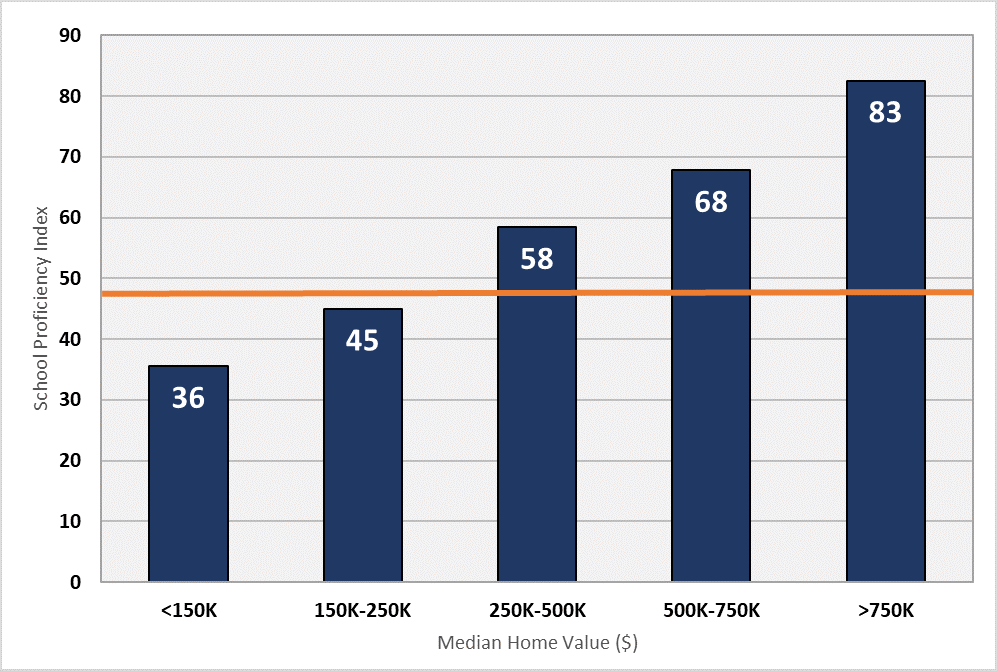Where do children in affordable housing go to school? (Part 1)
School quality is one of the most important considerations for a family when choosing where to live. However, a more critical aspect in deciding home location is affordability. More often than not, these two pieces don’t line up. If lower-income households could make housing location decisions based on school quality alone rather than affordability, they would typically choose to locate elsewhere.
Education, especially at an early age, is critical to social mobility. However, many children don’t have the opportunity to attend a high-quality school. Theoretically, subsidized affordable housing could help alleviate this mismatch and provide lower-income families the opportunity to send their children to better schools. As it is, however, most kids who grow up in subsidized housing are more likely to live near low-performing schools.
A series of two posts will narrow in on this reality Virginia. This first post will give a statewide overview at the neighborhood level of both (1) school quality as measured by the HUD school proficiency index and (2) housing cost as measured by median housing value. A second forthcoming post in this series will explore (1) where subsidized housing is located in Virginia and (2) how this relates to school quality.
Children in lower-cost housing should be able to attend good schools. By examining and highlighting the current mismatch between these two, steps can be taken to ensure that it doesn’t persist.
What is school quality?
School quality is a difficult concept to measure and put into numbers for comparison. The quality or value of a school varies based on individual preferences, and many of these are not easily quantified.
Although not perfect, school proficiency (student test scores) serve as a consistent representation of school quality and are historically the most widely used. This analysis uses the school proficiency index developed by the U.S. Department of Housing and Urban Development (HUD) to help communities analyze challenges to fair housing choice and establish their own goals and priorities to address the fair housing barriers in their community. The school proficiency index uses school-level data on the performance of fourth-grade students on state exams to describe neighborhood elementary school quality. Values are percentile-ranked and range from 0 to 100; the higher the score, the higher the school system quality is in a neighborhood.
The updating of the school proficiency index was suspended in early 2018, therefore the most recent data are from 2014. Relative school performance remains largely stable over time.
Why is school quality important?
Attendance at a high-performing school is critically important in determining short-term academic performance and long-term life outcomes such as college attendance, poverty, lifetime earnings, and health. Most students are assigned to and attend public schools located near their homes. Selection of housing in neighborhoods with a higher school proficiency index enables children to have access to higher-quality schools. Home location is therefore critical to long-term student success.
Where are the high-performing schools?
Figure 1: School proficiency in Virginia
View larger map
School proficiency levels vary widely across Virginia. High-performing schools tend to be clustered in the suburbs around the state’s major metro areas and in certain rural neighborhoods. Regionally, we see the highest average school proficiency index in the Hampton Roads region at 59, followed by Northern Virginia at 53. The West Central and Valley regions are also above the state average of 45. Southside has the lowest mean school proficiency score by far at 21, with the next lowest score being the Eastern region at 42.
Among counties, Bath County has the highest average school proficiency at 92 followed by New Kent County and Falls Church at 91. Loudoun, Highland, and Covington counties follow next at 82. Lunenburg County has the lowest average school proficiency score at 3 followed by Prince Edward County at 4.
Rural areas show some of the highest individual school index scores but also demonstrate more inequality when compared to urban areas with a greater range of scores. As a whole, rural areas underperform relative to metro areas – The average school proficiency in non-metropolitan areas is 38 compared to block groups in metropolitan areas which show consistently higher levels, averaging at 50.
School performance and median home value
Figure 2: Estimated typical (median) value of an owner-occupied home in Virginia
View larger map
A simple way to observe housing cost is to look at median home values. The map above shows the median value of owner-occupied homes by census block group in Virginia. Overall, it is not surprising that many of the higher median home value areas are located near urban centers, especially in Northern Virginia. However, there is some nuance when the data are narrowed down to the neighborhood level and local variability is revealed. Many rural and suburban areas adjacent to urban centers display high home values, while some pockets within urban areas display lower home values.
When median home value is compared to the school proficiency index a pattern emerges: as median housing values rise in a block group, the correlating school proficiency level rises also (Figure 3).

The value of a home that is located in a neighborhood where the school proficiency index is higher than the state average (49) appears to be around $300,000. This essentially prices a large portion of Virginians out of the opportunity to attend a high-performing school.
There are many factors that guide housing affordability. Hence this data does not imply that higher-performing schools alone cause higher home values or that higher home values necessarily result in higher-performing schools. However, the anecdotal relationships presented here demonstrate the difficulty of obtaining low-cost housing in an area where a family can send their children to a quality school.
Part 2 of this series will relate current subsidized housing locations with school performance and address potential housing policy solutions to ensure all children have access to equal educational opportunities.


